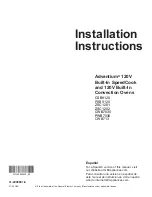
13
Successful Cooking
Browning
Meats and poultry that are cooked fifteen minutes or
longer brown lightly in their own fat. Foods that are
cooked for a shorter period of time may be brushed
with a browning sauce to achieve an appetizing
color.
The most commonly used browning sauces are
Worcestershire sauce, soy sauce, and barbecue
sauce. Add relatively small amounts of browning
sauces to foods so that you don’t alter the original
flavor of the recipes.
Covering with a lid or cling-film
A cover traps heat and steam and causes food to
cook more quickly. You may either use a lid or
microwave cling-film with a corner folded back to
prevent splitting.
Covering with waxed paper
Waxed paper effectively prevents spattering and
helps food retain some heat. Since it makes a
looser cover than a lid or cling-film, it allows the food
to dry out slightly.
Wrapping in waxed paper or paper towel
Sandwiches and many other foods containing pre-
baked bread should be wrapped prior to cooking to
prevent drying out.
Arranging and spacing
Individual foods such as baked potatoes, small
cakes, and hors d’oeuvres heat more evenly if
placed in the oven an equal distance apart,
preferably in a circular pattern. Never stack foods
on top of one another.
Stirring
Stirring is one of the most important of all
microwaving techniques. In conventional cooking,
you stir foods to blend them. You need to stir
microwaved food to spread and redistribute heat.
Always stir from the outside towards the center
since the outside of the food heats first.
Turning over
Large foods such as roasts and whole chickens
should be turned so that the top and bottom cook
evenly. It is also a good idea to turn cut-up chicken
and chops.
Placing thicker portions near the edge
Since microwaves are attracted to the outer portion
of foods, it makes sense to place thicker portions of
meat, poultry and fish near the outer edge of the
baking dish. In this way, thicker portions receive the
most microwave energy and the food cooks evenly.
Elevating
It is a good idea to elevate thick or dense food so
that microwaves are absorbed by the underside and
center of the food.
Piercing
Food that is enclosed in a shell, skin, or membrane
is likely to burst in the oven unless it is pierced prior
to cooking. Such foods include both egg yolks and
egg whites, clams and oysters, and many whole
vegetables and fruits.
Testing if cooked
Since food cooks so quickly in a microwave oven, it
is necessary to test it frequently. While some types
of food may be left in the microwave until it is
completely cooked, most food, such as meats and
poultry, should be removed from the oven while it is
slightly undercooked to allow for cooking outside of
the oven. The internal temperature of foods rises
between 5 °F (3 °C) and 15 °F (8 °C) during
standing time.
Allowing to stand
Foods are often allowed to stand for 3 to 10
minutes after being removed from the microwave
oven. Usually the foods are covered during
standing time to retain heat unless they are
supposed to be dry in texture (such as some
cakes and biscuits). Standing allows foods to
finish cooking and also helps flavors to blend and
develop.
SPECIAL TECHNIQUES















































